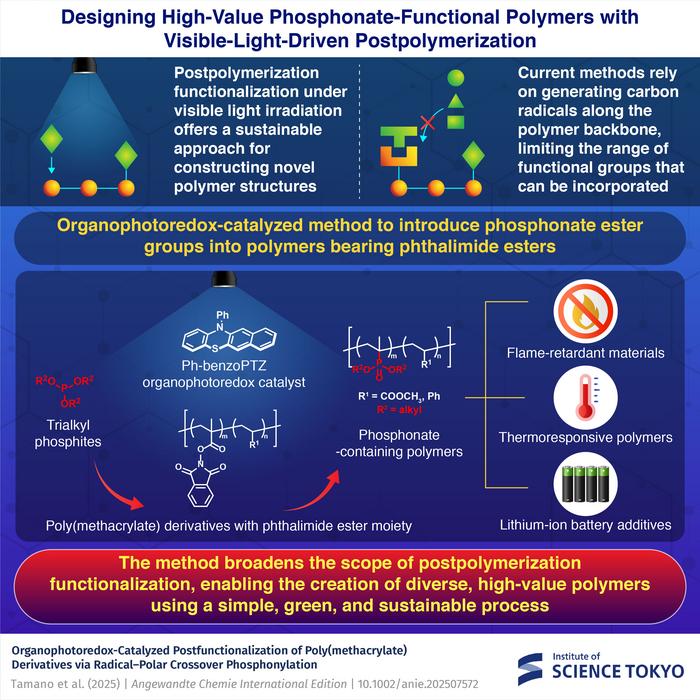
In a groundbreaking development poised to redefine the future of functional polymer design, researchers at the Institute of Science Tokyo have unveiled a novel postfunctionalization method that harnesses visible light to incorporate phosphonate esters into polymer chains. This innovative approach, led by Professor Shinsuke Inagi, utilizes an organophotoredox catalytic system to generate carbocation intermediates, thereby enabling a versatile and sustainable pathway to transform common polymers into high-value materials endowed with advanced properties such as fire resistance and temperature responsiveness.
The demand for specialized polymeric materials continues to accelerate across diverse sectors, from electronics to energy storage. Traditional polymer synthesis methods, while effective, often lack flexibility and environmental compatibility when tailoring polymers with complex functional groups. Postfunctionalization—a strategy that modifies pre-formed polymer backbones by introducing new moieties—has emerged as a promising route to circumvent these challenges. Unlike conventional techniques that rely heavily on radical intermediates, limiting the scope of feasible chemical modifications, the method developed at the Institute of Science Tokyo pioneeringly introduces a radical–polar crossover mechanism, broadening the chemical landscape for polymer modification.
At the heart of this advancement lies an organophotoredox catalyst, specifically 12-phenyl-12H-benzo[b]phenothiazine (Ph-benzoPTZ), which mediates the transformation under blue LED light irradiation. The process initiates with the formation of an electron donor–acceptor complex between the catalyst and polymer-bound phthalimide ester groups. Upon photoexcitation, electron transfer disrupts the phthalimide ester, releasing carbon dioxide and generating carbon-centered radicals along the polymer backbone. This pivotal step is followed by a secondary electron transfer, transforming these radicals into carbocation equivalents—highly reactive positively charged intermediates rarely accessible in polymer postfunctionalization.
.adsslot_yKWQp3dlJa{width:728px !important;height:90px !important;}
@media(max-width:1199px){ .adsslot_yKWQp3dlJa{width:468px !important;height:60px !important;}
}
@media(max-width:767px){ .adsslot_yKWQp3dlJa{width:320px !important;height:50px !important;}
}
ADVERTISEMENT
These carbocation species exhibit remarkable reactivity toward trialkyl phosphites, serving as nucleophiles to introduce phosphonate ester functionalities directly onto the polymer chain. The incorporation of phosphonate groups is particularly significant due to their inherent chemical robustness and ability to impart flame retardancy and thermal responsiveness. Importantly, the process accommodates a range of trialkyl phosphites, including those bearing chloro and trifluoromethyl substituents, underscoring the method’s versatility and potential for tuning polymer properties via tailored functionalization.
One of the notable achievements of this technique is its success in modifying poly(methacrylate) derivatives containing phthalimide ester functionalities. These modifications result in copolymers comprising diethyl isopropenylphosphonate, propylene, and methyl acrylate units, which have proven difficult to synthesize through standard radical polymerization methods. Moreover, the strategy effectively functionalizes precursors composed of styrene and phthalimide monomers, achieving functionalization degrees ranging from 7% to 21%. This level of control heralds new opportunities for designing polymers with bespoke architectures and functional group distributions.
Professor Inagi emphasizes that such postfunctionalization advances address critical limitations in copolymerizing olefins with activated vinyl monomers, a longstanding challenge due to poor olefin incorporation and harsh reaction conditions typically required. By elegantly circumventing these obstacles, the method enables phosphonate groups’ integration into olefin–methacrylate copolymers under mild, sustainable conditions, significantly expanding the attainable polymer chemical space.
The applications of these phosphonate-functionalized polymers are multifaceted. Their inherent fire-retardant characteristics make them ideal candidates for enhancing safety profiles in materials used in electronics and building sectors. Equally compelling is their potential role in lithium-ion battery technology; by acting as flame-retardant additives, these polymers could mitigate risks associated with battery fires, addressing an urgent safety concern in energy storage devices. Additionally, the temperature-responsive behavior of these materials opens avenues for smart coatings and responsive membranes, facilitating their adoption in cutting-edge technological applications.
A central advantage of this organophotoredox-catalyzed radical–polar crossover mechanism is its reliance on visible light as a sustainable energy source, eliminating the need for harsh reagents or elevated temperatures typically involved in polymer modification. The mild reaction conditions preserve polymer integrity while affording high selectivity and functional group tolerance. This methodological elegance further promotes environmentally benign practices in polymer chemistry, aligning with global efforts toward green and sustainable material synthesis.
The collaborative nature of this research, involving scientists from both the Institute of Science Tokyo and Kyoto University, highlights the interdisciplinary approach necessary to tackle complex chemical challenges. The study, published in the renowned journal Angewandte Chemie International Edition, serves as a testament to the innovative spirit driving contemporary materials science and photochemistry, combining strategic catalysis with polymer engineering to unlock unprecedented molecular transformations.
Looking forward, the research team aspires to extend their strategy to incorporate a broader spectrum of functional groups, thereby constructing next-generation polymers with diverse and tailored functionalities. Such endeavors promise to accelerate advancements in material performance and sustainability, impacting fields ranging from biomedicine to environmental technology. The modularity and tunability inherent in this photoredox-induced postfunctionalization herald a new paradigm for smart material development.
In sum, this pioneering organophotoredox-catalyzed postfunctionalization approach not only overcomes traditional limitations in polymer chemistry but also embodies the confluence of sustainability, innovation, and functionality. By leveraging the power of visible light to orchestrate complex radical and polar intermediate transformations, the research paves the way for a new class of high-value polymers with far-reaching implications across science and industry. As we strive for materials that meet the evolving demands of modern technologies, methodologies like this exemplar demonstrate how fundamental chemistry can propel us toward a smarter, safer future.
Subject of Research: Not applicable
Article Title: Organophotoredox-Catalyzed Postfunctionalization of Poly(methacrylate) Derivatives via Radical–Polar Crossover Phosphonylation
News Publication Date: 15-May-2025
Web References:
https://doi.org/10.1002/anie.202507572
Image Credits: Institute of Science Tokyo
Keywords
Materials science, Materials engineering, Engineering, Polymers, Chemical compounds, Chemistry
Tags: advanced polymer propertiesenvironmentally friendly polymer synthesisfire-resistant materialsfunctional polymer designhigh-value polymer materialsorganophotoredox systemsphosphonate esters in polymerspostfunctionalization techniquesradical-polar crossover mechanismsustainable polymer modificationtemperature-responsive polymersvisible light catalysis





